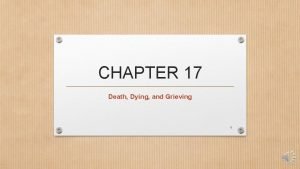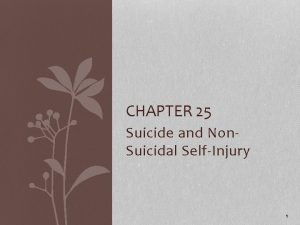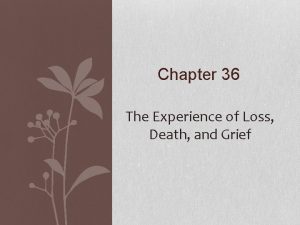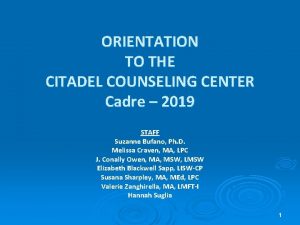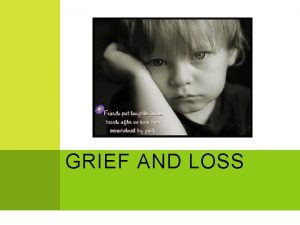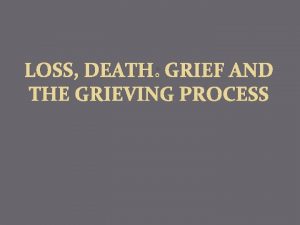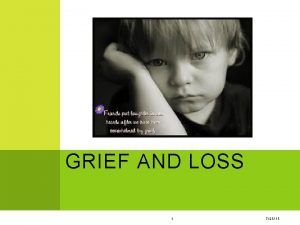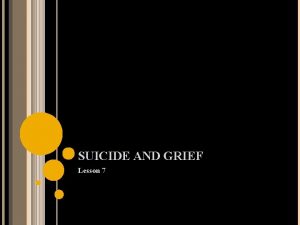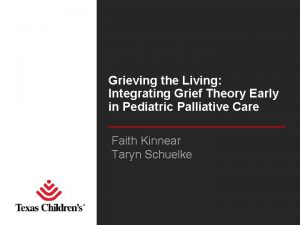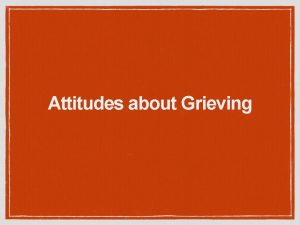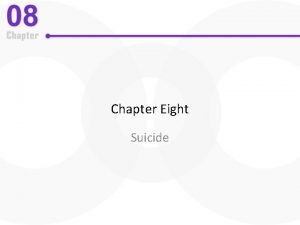GRIEF AND SUICIDE THE GRIEVING PROCESS Grief express













- Slides: 13

GRIEF AND SUICIDE

THE GRIEVING PROCESS Grief – express deep sadness because of loss 5 stages of grieving process Denial: gives you a chance to think Anger: normal (anger management) Bargaining: promise to change Depression: short term is normal Acceptance: learn how to live with the loss

FUNERALS, WAKES, AND MEMORIAL SERVICES Purpose: Help the family get through the grieving process. Wake – view or watch over deceased person before funeral. Funeral – ceremony in which deceased person is buried. Memorial Service – ceremony to remember the deceased.

WHAT ARE SOME DIFFERENT THINGS YOU’VE SEEN AT FUNERALS OR MEMORIALS?

COPING WITH LOSS Loss can cause stress. What are some physical and emotional effects of stress? Tension headaches, increase in blood pressure, irritable, confused, stress related illness.

HELP FOR DEALING WITH LOSS Helping yourself Get plenty of rest/relaxation but stick to any normal routine Helping others Share memories Show your support through simple Express your feelings actions Don’t blame yourself Let the person know you are there for him/her Tell the person they are strong and will learn to live with the loss

A PERMANENT SOLUTION TO A TEMPORARY PROBLEM. SUICIDE: Words that warn: Definition: the act of intentionally taking one’s life Why is suicide an uncomfortable topic? What are some myths or facts about suicide? “I wish I were dead. ” “I just want to go to sleep & never wake up. ” “I won’t be a problem for you much longer. ” “I can’t take it anymore. ” “This pain will be over soon. ” “Nothing matters. ”

FACTS ABOUT SUICIDE Many people who consider suicide only do so for a brief period in their life Most people who have attempted and failed are usually grateful to be alive Suicide has many warning signs Use of drugs/alcohol can put people at risk because of impaired judgment

FACTS ABOUT SUICIDE CONT. 3 rd leading cause of death for ages 15 – 24 Depression and bipolar disease are major risk factors. Stressful life events and low levels of communication with parents are also significant risk factors. More women attempt suicide and more men commit suicide. In 2010, males aged 15 -19 were 4 X more likely to commit suicide than females.

KEEP IN MIND! It should be noted that some people who die by suicide do not show any suicide warning signs. But, about 75 percent of those who die by suicide do exhibit some suicide warning signs, so we need to be aware of what the suicide warning signs are and try to spot them in people. If we do see someone exhibiting suicide warning signs, we need to do everything that we can to help them. Suicide. org

WARNING SIGNS FOR SUICIDE Feeling hopeless Withdrawing from family and friends Neglecting basic needs Experiencing loss of energy Taking more risks Using alcohol and drugs Giving away personal things

GIVING AND GETTING HELP Take all talk of suicide seriously Tell your friend suicide is not the answer Change negative thoughts into positive ones Don’t keep a secret

N. S. S. I. v. Non-Suicidal Self-Injury v. Common forms of NSSI: Cutting, burning, scratching, skin-picking, hair-pulling v 90% of people who self-injure begin cutting as teens v. Self-injury is prevalent in ALL races and economic backgrounds. Video #1 Video #2
 Powerlessness nursing care plan
Powerlessness nursing care plan One beneficial aspect of grieving is that it
One beneficial aspect of grieving is that it The sad persons scale
The sad persons scale Lesson 3 coping with loss and grief
Lesson 3 coping with loss and grief Chapter 36 loss and grief
Chapter 36 loss and grief Seven stages of grief
Seven stages of grief The three learned emotions are grief shame and
The three learned emotions are grief shame and Uvita suicide
Uvita suicide Mad acronym suicide prevention
Mad acronym suicide prevention Citadel counseling center
Citadel counseling center Youth suicide research consortium
Youth suicide research consortium Correct order
Correct order Icd post kll
Icd post kll Glencoe health chapter 5 answer key
Glencoe health chapter 5 answer key

